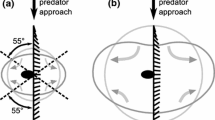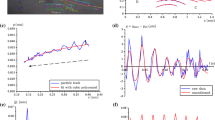Abstract
When particles move through fluids, they produce far-field pressure differences and near-field fluid deformations. Here we evaluate if a copepod, relying on mechanoreceptive antennulary setal hairs, can detect pressure changes caused by a variety of signal sources. We first provide a correction of the copepod mechanoreception model of Legier-Visser et al. (1986), showing how an object above a minimum size should be detectable. The pressure change ΔP created by an object of this minimum size was 385 dynes/cm2, based on biomechanical relationships for a rigid seta bending with respect to the exoskeletal body and using the neurophysiological detection threshold of a 10 nm bend of the sensory seta (Yen et al., 1992). The ΔP for: a 3 μm particle = 0.01 dynes/cm2, a 50 μm particle = 0.16 dynes/cm2, an escaping nauplius = 78 dynes/cm2, a revolving prey = 10−5 dynes/cm2, a 1 mm copepod escaping at 1 m/s at a distance of 1 mm from the mechanoreceptive sensory hairs of its captor = 312 dynes/cm2. Only the copepod escaping at high-speed close to the captor would create a pressure difference that could elicit a response. At this point, we conclude that pressure differences are rarely of a magnitude that is perceptible and that additional information must be derived for a copepod to detect prey. Other signals include fluid deformations as well as other types of stimuli (odor, shadows). Like most organisms, a copepod will rely on all sensory modalities to find food, avoid predators, and track mates, assuring their survival in the aquatic environment. It also is possible that the biomechanical model is insufficient for estimating pressure differences causing the cuticular deformation or that further analysis is necessary to improve our certainty of the sensitivity of the copepod seta.
Similar content being viewed by others
References
Alcaraz, M. & J. R. Strickler, 1988. Locomotion in copepods: Pattern of movements and energetics of Cyclops. Hydrobiologia 167-168: 409-414
Alexander, D. E., J. Blodig & S-Y. Hsieh, 1995. Relationship between function and mechanical properties of the pleopods of isopod crustaceans. Invert. Biol. 114: 169-179.
Bundy, H. M., T. F. Gross, H. A. Vanderploeg & J. R. Strickler, 1998. Perception of inert particles by calanoid copepods: behavioral observations and a numerical model. J. Plankton Res. 20: 2129-2152.
Doall, M. H., J. R. Strickler, D. M. Fields & J. Yen, 2001. Mapping the attack volume of a free-swimming planktonic copepod, Euchaeta rimana. Marine Biology. ‘Online Publication, DOI: 10.1007/s00227-001-0735-z’.
Fields, D. M., D. S. Shaeffer & M. J. Weissburg, 2001. Mechanical and neural responses from the mechanosensory hairs on the antennule of Gaussia princeps. Mar. Ecol. Progr. Ser.: 227: 173-186.
Fields, D.M. & J. Yen, accepted. Fluid mechanosensory stimulation of behavior from a planktonic marine copepod Euchaeta rimana Bradford. J. Plankton Res.
Fields, D. M. & J. Yen, 1997. The escape behavior of marine copepods in response to a quantifiable fluid mechanical disturbance. J. Plankton Res. 19: 1289-1304.
Fields, D. M., 1996. Interactions of marine copepods with a moving fluid environment. Ph.D. thesis. SUNY-Stony Brook.
Forward, R. B., Jr., 1988. Diel vertical migration: zooplankton photobiology and behavior. Oceanogr. mar. biol. Annu. Rev. 26: 361-393.
Harris, G. G. & W. A. van Bereijk, 1962. Evidence that the lateralline organ responds to near-field displacements of sound sources in water. J. Acoust. Soc. am. 34: 1831-1841.
Hawkins, A. S. & A. A. Myrberg, 1983. Hearing and sound communication under water. In Lewis, B. (ed.), Bioacoustics, a Comparative Approach. Academic Press, New York: 347-405.
Jensen, M. & T. Weis-Fogh, 1962. Biology and physics of locust flight V: strength and elasticity of locust cuticle. Phil. Trans. r. Soc. B 245: 137-169.
Jiang, H., T. R. Osborn & C. Meneveau, 2002. Hydrodynamic interaction between two copepods: a numerical study. J. Plankton Res. 24: 235-253.
Kalmijn, A. D., 1988. Hydrodynamic and acoustic field detection. In Atema, J., R. R. Fay, A. N. Popper & W. N. Tavolga (eds), Sensory Biology of Aquatic Animals. Springer-Verlag, New York. U.S.A.: 83-130.
Kirk, K. L., 1985. Water flows produced by Daphnia and Diaptomus: implications for prey selection by mechanosensory predators. Limnol. Oceanogr. 30: 679-686.
Langlois, W. E., 1964. Slow Viscous Flow. Macmillan Co., New York: 137 pp.
Legier-Visser, M. F., J. G. Mitchell, A. Okubo & J. A. Fuhrman, 1986. Mechanoreception in calanoid copepods. Mar. Biol. 90: 529-535.
Meyers, D. G. & J. M. Farmer, 1982. Gravity receptors in a microcrustacean water flea: function of antennal-socket setae in Daphnia magna. The Physiologist 25: suppl.
Pedley, T. J., 1977. Scale Effects in Animal Locomotion. Academic Press, New York: 545 pp.
Strickler, J. R., 1975. Intra-and interspecific information flow among planktonic copepods: receptors. Verh. int. Ver. Limnol. 19: 2951-2958.
Strickler, J. R., 1977. Observation of swimming performances of planktonic copepods. Limnol. Oceanogr. 22: 165-169.
Tautz, J., 1979. Reception of particle oscillation in a medium-an unorthodox sensory capacity. Naturwissenschaften 66: 452-461.
Vanderploeg, H. A., G.-A. Paffenhofer & J. R. Leibig, 1990. Concentration-variable interactions between calanoid copepods and particles of difference food quality: observations and hypo 173 theses. NATO ASI Series G20. In Hughes, R. H. (ed.), Behavioral Mechanisms of Food Selection. Springer-Verlag, Berlin: 595-613.
Wainwright, S. A., W. D. Biggs, J. D. Curry, and J. M. Gosline, 1976. Mechanical Design in Organisms. Princeton University Press, Princeton: 423 pp.
Wilson, S., 2001. Predator-prey interactions in the plankton: escape responses of three calanoid copepod species from a juvenile fish. M.S. thesis, SUNY-Stony Brook.
Yen, J., 1985. Selective predation by the carnivorous marine copepod Euchaeta elongata: laboratory measurements of predation rates verified by field observations of temporal/spatial feeding patterns. Limnol. Oceanogr. 30: 577-595.
Yen, J., 1988. Directionality and swimming speeds in predator-prey and male-female interactions of Euchaeta rimana, a subtropical marine copepod. Bull. mar. Sci. 43 (3): 175-193.
Yen, J., P. H. Lenz, D. V. Gassie & D. K. Hartline, 1992. Mechanoreception in marine copepods: electrophysiological studies on the first antennae. J. Plankton Res. 14 (4): 495-512.
Yen, J. & D.M. Fields, 1994. Behavioral responses of Euchaeta rimana to controlled fluid mechanical stimuli. (Abstr.) EOS, Trans. am. Geophys. Union 75: 184.
Yen J. & J. R. Strickler, 1996. Advertisement and concealment in the plankton: what makes a copepod hydrodynamically conspicuous? Invert. Biol. 3:191-205.
Zaret, R. E., 1980. The animal and its viscous environment. In Kerfoot, W. C. (ed.), Evolution and Ecology of Zooplankton Communities. Hanover: University Press of New England: 3-9.
Author information
Authors and Affiliations
Rights and permissions
About this article
Cite this article
Yen, J., Okubo, A. Particle and prey detection by mechanoreceptive copepods: a mathematical analysis. Hydrobiologia 480, 165–173 (2002). https://doi.org/10.1023/A:1021249521259
Issue Date:
DOI: https://doi.org/10.1023/A:1021249521259




